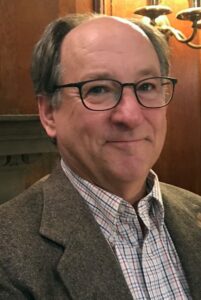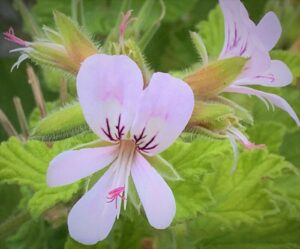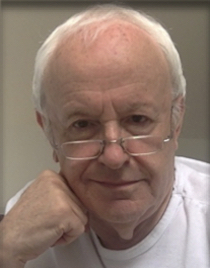June 18, 2020
The 2Blades Foundation Board Chair Roger Freedman recently engaged in a wide-ranging conversation with our new Board Member, Rob Horsch, discussing everything from their career journeys and the evolution of plant science in recent decades, to institutional structures and resource allocation decisions necessary for achieving food security, and potential opportunities for the 2Blades Foundation research agenda in the coming years. The two also offered their advice for young people considering a career in the biological sciences.

Dr. Rob Horsch
Horsch recently left the Gates Foundation, which he joined in 1996 to develop and lead the science and technology initiative of the Foundation’s agricultural development program. Rob also serves on the Board of Directors of the Foundation for Food and Agricultural Research and as an Advisor to the Global Commission on Climate Adaptation and to the Global Farmer Network. He joined Monsanto in 1981 and led the company’s plant tissue culture and transformation efforts, and also led their programs for International Development Partnerships with responsibility to help small-holder farmers in developing countries gain access to better agricultural products and technologies.
Rob received his Ph.D. in Genetics at the University of California, Riverside, in 1979, and then conducted postdoctoral work in plant physiology at the University of Saskatchewan. He has served on the editorial boards of several leading journals in the plant sciences and as an advisor to the National Science Foundation and the Department of Energy. He was awarded the 1998 National Medal of Technology by President Clinton for contributions to the development of agricultural biotechnology.
Rob Horsch: How did you get interested in science, plant science, or agriculture?
Roger Freedman: I’d never worked in the area and I knew the names of about 3-4 plants. I could identify a rose, a potato if it was dug up out of the ground, and dandelions. I lived for a while with some friends in an old cottage in the woods outside Cambridge. They were keen gardeners and cooks, and their example inspired me to start cooking myself and to turn my tiny garden in Cambridge into a herb garden. So one day I was making a black currant sorbet, and the recipe said to take a leaf from a rose scented geranium and put it in the bottom of the tin in which you’re freezing the sorbet and it would give its flavor to the sorbet.
“…she took a knife and cut a bit off her own plant and said, ‘Here you are, stick that in some compost and you’ll have your geranium.’ I couldn’t believe it. I was so skeptical that I actually repeated it several times to make sure that it worked, and it worked every time. I got very interested.” Roger Freedman
And I didn’t know what a scented leaf geranium was, so I went to see my gardening and cooking friend from my time in the woods and asked whether she had any seeds for this plant. She said you don’t use seeds, and to my horror she took a knife and cut a bit off her own plant and said, “Here you are, stick that in some compost and you’ll have your geranium.” I couldn’t believe it. I was so skeptical that I actually repeated it several times to make sure that it worked, and it worked every time. I got very interested. I went to a nursery and purchased a bunch of different geraniums and started breeding, doing crosses on my windowsill.

Rose-Scented Geranium
I was increasingly intrigued and went to see Dick Flavell who was at the plant breeding institute at Cambridge and asked if I could audit the MPhil course, and he said, “Yeah, you can’t come to the practicals, but you can audit the course.” So, I started studying it. This was the time when you, Rob, were doing something sensible with Fraley and Steve Rogers and the very first publications about transformation of plants came out. Dick introduced these findings into the course, and I was seized with the possibilities of what you could do with transgenic plants.
And I talked a lot about this; I was obsessed, and talked to my old friend David Sainsbury and one day he said to me, ‘This stuff you’re always talking about, I’ve got a (venture development) company and maybe we should be doing something with this stuff you’re always telling me about. Will you do a study for me?” And I jumped at it because I thought this was a chance to get something really interesting started in the UK. So I set off to find out more about what was happening in the UK – which in fact was nothing – but I did find some interesting stuff that really was worth developing and I presented a report to the company’s board and they decided that they would open up a line of investment in plant technology. And they found someone – Roger Hay – to lead that and I was very upset, and I said to David “Well, I wanted that job” and he said, “No you didn’t” and he was right. And he set up another company which was for a colleague Christopher Stone and me, and gave me a budget which I started spending on what I thought were early-stage investment possibilities.
To a degree these were based on new technologies but as you well know, though many of the key discoveries in biology have come from studying plants, it has always been a neglected area relative to studies that support medicine. I remarked this to David; that just as the technology for transforming plants had become available what it revealed was that we knew very little about plants. And he said “Take £250,000 a year for the next three years and give it away. All I ask is that you support outstanding science.” That was the whole brief and it was the beginning of funding by the Gatsby Foundation. So, it’s kind of gone on from there.
Horsch: Things fascinated you and you’ve followed that fascination.
Freedman: How did you get into it? I’m no historian but there were some crucial papers, which you’ve had your name on along with your colleagues. It’s clear you made a very major contribution in the very early days of the subject.
“My advisor, a biology professor, said he was setting up a new program in quantitative biology and he thought I’d be a perfect candidate for it. I later discovered I don’t like blood and guts and therefore I ended up studying plants. It’s as simple as that. Starting down a path and then hitting walls and bouncing till I ended up working in plants.” Rob Horsch
Horsch: it started with an interest and fascination with mathematics. I took advanced placement math then college courses while I was in high school. My first year in college. I got to the second year of differential equations and found that what was easy and intuitive in earlier courses became impossible for me. I just hit a wall and thought, “no more mathematics.”
My advisor, a biology professor, said he was setting up a new program in quantitative biology and he thought I’d be a perfect candidate for it. I later discovered I don’t like blood and guts and therefore I ended up studying plants. It’s as simple as that. Starting down a path and then hitting walls and bouncing till I ended up working in plants. I must admit that I was just in the right place and right time to jump into molecular biology. All the molecular stuff had broken open in microbes at that point, and I was thinking, along with thousands of other people, it’s time to apply this to plants.
I interviewed at universities, and small and big companies. I thought that the team led by Ernie Jaworski at Monsanto, with Fraley and Rogers, was the place that was most serious. They had the most logical, organized strategy to go about trying to adapt the microbial tools to plants. Everybody else was excited and enamored, you know, cheering and waving their arms about how wonderful this could be, but they didn’t have operational plans or organization that Ernie had brought to the little group he was starting in the central research labs at Monsanto. I picked them because they were the most serious. We just executed the strategy, trying lots of different things — a little bit like Thomas Edison, trying many filaments and assuming nothing was going to work without great manual effort. It turned out partially true and partially not true. Some things worked like a charm, other approaches proved to be impractical, and pretty soon we had transgenic plants. Excellence in science was always a hallmark for our program.
When I was still young in the job the CEO of the company, Dick Mahoney, came to see me, and he asked why it was that I was pushing to publish the work when it was a company secret. I asked him if he thought he was smart enough and had enough technical expertise to know if our work was good science or crap science. And he said “Well, I can’t tell.” I said that’s why you have to let us publish in the best journals possible, to see if it passes peer review. Then he asked, “how can we protect our intellectual property if we don’t keep it secret?” I said, a trade secret is your last resort because it won’t last. We’re not that much smarter than everybody else in the world. We’re just better organized. We have a lead but in a very short period of time everybody else will figure this out too. To try to protect it by keeping it secret it’s going to evaporate, but if you file patents, we may get a semi-enduring lead — 17 years. He, said “Yeah that makes sense.” So, we ended up publishing and patenting.
Peer review was even more important than I had realized. The public research system, the university system, and the extension research systems for testing methods and products are an essential component of agriculture because it gives unbiased good science data to farmers – and this is why you do double-blind experiments. Everybody has biases whether they know it or not. If you test your own product, even when your intention is to be absolutely rigorous, you’re still going to be subject to unintentional bias. So, having somebody else test the science, reproduce the science, do the comparisons, is actually a critical part of our whole system.
Freedman: What was it like working in that small group in the very early days?
“…the whole spirit has been one of having an important mission and a shared success that kept everybody working hard and wanting to make it succeed.” Rob Horsch
Horsch: Well amazingly it was like working on a team where people had a common goal and wanted everybody to succeed at their part of it. There was almost no internal competition. I had friends at other companies who told me stories of horrible rivalries and not helping each other – in fact, hoping other folks would fall behind so they would look better. That dysfunctionality would have been a killer. We had common objectives, lots of meetings and discussions and sharing ideas while challenging each other. It’s the sort of thing that I think once you start down that road becomes self-reinforcing, and if you don’t start down the road, it becomes self-excluding. One of the things that attracted me to 2Blades is that every interaction I’ve had with you and with the board and scientists you’ve supported has been one of a common mission of working together on something important and worthwhile. Asking the hard questions, not just being self-congratulatory, but to say “Is this working? Should we look at this different and is it time to take a different tack? Or should we double down?” I thought the whole spirit has been one of having an important mission and a shared success that kept everybody working hard and wanting to make it succeed. I found that wonderful.

Freedman: I have always felt that people who are drawn by their curiosity to learn more about plants through doing research – everyone I’ve met really – would love to see what they do make a contribution to human betterment. I think in the case of work on plant pathogens, Rachel Carson’s Silent Spring must have had an influence on people and kind of left them thinking there had to be a better way. The members of our Scientific Advisory Board, for example, are distinguished scientists and very busy people and every single one of them when I approached them and asked them to help us said yes. We pay them nothing. I think the key to that is that we’re a not-for-profit. There’s nothing in it in terms of dividends or capital gain participation or anything like that, and they know that the motivation is just to help make a better agriculture.
Horsch: Don’t underestimate the power of creating a space where people can do that – it is rarer than you may realize.
Freedman: So how did you come to make the move to the Gates Foundation?
Horsch: I was getting tired of my job at Monsanto. I had branched into international development and I loved it. Then the company began angling me into public relations, and I didn’t love it. And the dilemma was that I was good at it and I didn’t like doing it. I liked doing the development work. I began thinking I wanted to do a second career in a non-profit area. Only there was no non-profit space that was attractive enough. So, I was in a holding pattern. Our CEO had retired, and he told me that a friend of his worked at the Bill and Melinda Gates Foundation and they were thinking about going into agriculture. They wanted to interview him to get advice about what they should do in agriculture. He asked me what I thought he should tell them? We set up an appointment to discuss it.
The next day a friend inside the company came to me and said he just got back from a meeting where he met somebody from the Gates Foundation who said they were going to interview our former CEO and they want to know what questions to ask him. So, I made a Q&A list and gave half of it to each of the parties. It went so well that afterwards the former CEO was asked to organize a symposium. So, I organized a symposium for him. I think the foundation figured out who was behind the symposium. They called me the next week to get names of people who they could recruit for a new ag program. I began to suggest some people, but they said, “Actually we want you.” I went out for an interview, they made me an offer, and I decided to take it.
Freedman: That’s pretty cool. Any reflections on your experience there:
“The history of development is to start with the staples and then move into higher-value, more diverse fruits and vegetables. If you don’t get the staples working efficiently, you can’t afford to move out of them. To me the logic was unassailably clear.” Rob Horsch
Horsch: It’s a private foundation and it’s risk-taking. Quite a few projects that sounded good at the time turned out not be very effective. The saving grace is their obsession with data and measuring progress would lead one to figure out a project wasn’t working and then allow a change in course. To develop an R&D strategy and priority targets, I started quantitatively assessing needs and opportunities. One school of thought was to bring back improved varieties of lost crops – crops that nobody grows and nobody eats, but were consumed historically. There’s several thousand of them, and they’re all interesting. The alternative was the very few boring crops that poor farmers grow and poor consumers eat.
My choice was to work on the big, boring stuff – not because that’s where we want the world to end up, eating a small number of common staples – but because that’s where you start to get people out of a deep, deep hole. The history of development is to start with the staples and then move into higher-value, more diverse fruits and vegetables. If you don’t get the staples working efficiently, you can’t afford to move out of them. To me the logic was unassailably clear. An internal argument was that we should be doing fruits and vegetables that are good for people, and I said yes, but you can’t start with fruits and vegetables because they’re way too expensive. One year’s worth of calories from corn will buy you a couple days’ worth of apples. Once you have all the corn you can use then you can start eating apples. it’s not quite intuitive, but we have to fix corn so people can eat apples.
Freedman: Really interesting information and utterly pertinent to what we’re all aiming to do.
Horsch: We focused on the top 15 crop species that accounted for well over 85 percent of calories and other nutrients for poor people. Then within each crop we looked at what the major problems were, and, as you well know, in wheat, diseases were the number one problem. In corn, drought and stresses – but not diseases – were the major problems. In cassava, viruses were the number one problem. And so, we rank-ordered the problems, and as long as they were big enough, we started investing in solutions. The last criteria was, “is there enough known to test hypotheses about potential solutions as opposed to simply studying the problem?”
Freedman: If you look at the biggest unsolved disease problems of the major crops there’s enough of an indication to suggest that solving those things will be useful, and so we’re very focused. We’re interested in producing potential products.
Horsch: The other thing I love about 2Blades is your implicit understanding that the problem isn’t static, that the problem keeps evolving. And so, the solution isn’t static, the solution is a system that can keep solving the problem.
“But that has to be of the essence in plant pathology because the disease will always win and if that isn’t part of your thinking and you just think oh, it’s solved, anyone can tell you that you are deluding yourself.” Roger Freedman

Dr. Roger Freedman
Freedman: But that has to be of the essence in plant pathology because the disease will always win and if that isn’t part of your thinking and you just think oh, it’s solved, anyone can tell you that you are deluding yourself. In the case of wheat, the pathogen is evolving rapidly. It’s very striking that since the emergence of Ug99 wheat stem rust there have been multiple derivatives which appeared in the last 20 years in Africa, but there are two virulent varieties of the pathogen that are completely different that have popped up. We’ve got a proof of concept to address the challenge, but actually what we have to do is to create a resource which can be used rapidly to produce responses to an evolving pathogen population, which is quite different from what we’ve faced in the case of Asian soy rust where it just seems as though the pathogen hasn’t been moving in that way. We have to have a reserve of genes which we can deploy, and we have to have a technology which allows us to generate new wheat varieties with new resistance combinations rapidly. That seems to me to be essential.
Horsch: It’s a core part of why the work we (2Blades) are supporting is so important and exciting. Regarding the question of what would get other funders and people interested, the first is absolute need – how important something is. There could be a strong need for something, like a COVID-19 vaccine, where the absolute need is incredibly high. In agriculture, wheat rusts and similar diseases have a very high absolute need. The second issue is a different dimension. It’s return-on-investment. If something can be done with a big return for a given amount spent it becomes more attractive – and this is why Bill and Melinda Gates got into vaccines. They saw that for $5 they could save an infant’s life.

Photo Credit: Kansas State University
It was a very important breakthrough that Gates adopted wholeheartedly in prioritizing both the magnitude of the problem and the return-on-investment of doing something about it. The third category I describe as Humpty Dumpty’s meaning of the word “Glory.” In Alice in Wonderland by Lewis Carroll, Mr. Dumpty said, “ ‘There’s glory for you!’ ‘I don’t know what you mean by glory,’ Alice said. Humpty Dumpty smiled contemptuously. ‘Of course you don’t — till I tell you.’ ” By this I mean to just ask a potential donor what is important to them. Need, return, and glory are the big drivers for why somebody would fund work like this. It is a very high return-on-investment space. One of the best books on this subject is by a Vaclav Smil, a retired professor who has written many wonderful books. He documents that the return on investment for agricultural development has been outrageously high, and continues to be so.
Freedman: Do you have advice for young people getting into the space?
Horsch: My advice Roger has always been be really good at something and then follow your heart wherever you want to go.
Freedman: It’s good advice
“Even if you’re excellent in something that turns out not to be important in the long run, you still learn what excellence is and then you can apply that distinction to more important things as you and the world evolve. So, I’ve always advised young folks to be really good at something.” Rob Horsch
Horsch: And this goes back to the 2Blades belief in excellence and science. I think people who haven’t experienced excellence in something are missing a major concept. Even if you’re excellent in something that turns out not to be important in the long run, you still learn what excellence is and then you can apply that distinction to more important things as you and the world evolve. So, I’ve always advised young folks to be really good at something.
Freedman: And then follow your heart. Seeing excellence just about anywhere has the power to reduce me to tears. Well, you’ve already been tricked by me into agreeing that you’re going to make a bigger, more visible, and valuable contribution to the way 2Blades thinks about things and I think that’s great. How can we improve our programs? You’ve said a lot of nice things, so now will you please say some critical things?
Horsch: I think critical ideas have to be treated as a hypothesis to be tested rather than an indictment to be served. But recognizing the financial resources are fairly small, their use has to be highly prioritized. One of the guys who I’ve learned a lot of stuff from had developed a concept he called partner leverage. That’s where you enroll others to invest in a common project, perhaps doing even more than you are able to do. I know we’re already going down that path, but I would think about it harder and more deliberately, more explicitly.
The example with Microsoft is all the other companies who invested in improving the value of Microsoft products by working on them, integrating them into their own systems, and getting their customers to buy Microsoft products. The amount Microsoft spent on R&D is actually a small fraction of what everybody else spent on improving the value of Microsoft products. That’s a brilliant concept that they used to great advantage. And with 2Blades, finding people that can take on the heavy lifting that gets very expensive really fast is going to have more leverage than trying to find funders who will pay for it.
Keeping the priority on the cutting-edge areas just seems higher return to me. There is a balance because proof-of-concept is critical to getting people to think something’s real, and yet it gets so expensive so fast, that’s where the trade-offs have to be.
 2Blades
2Blades